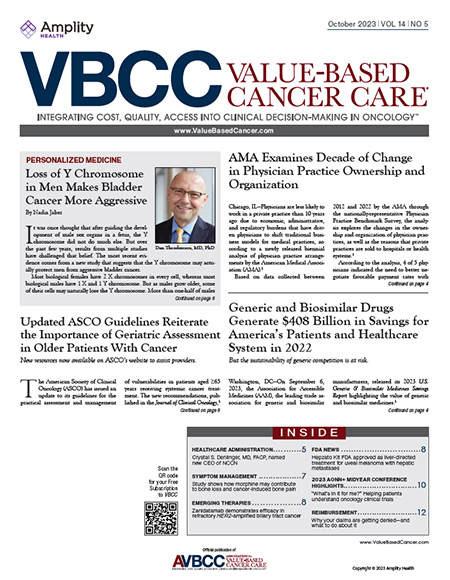Phase 2 results from MajesTEC-1 showed substantial clinical activity with teclistamab and are consistent with phase 1 findings.
Patients with multiple myeloma (MM) who progress after immunomodulatory agents, proteasome inhibitors, and anti-CD38 antibodies generally have poor outcomes and have limited remaining treatment options. B-cell maturation antigen (BCMA) has become a promising new target for MM treatment, with 3 BCMA-directed therapies recently approved for relapsed/refractory MM (RRMM) patients. Teclistamab is a bispecific antibody that targets CD3 on the surface of T-cells and BCMA on the surface of myeloma cells, resulting in T-cell activation and lysis of BCMA-expressing myeloma cells. In the phase 1 portion of MajesTEC-1, the recommended phase 2 dose of teclistamab was identified as 1.5 mg/kg administered weekly as subcutaneous injections. At this dose, efficacy in 40 RRMM patients was promising, with 65% of patients having a partial response or better. Phillipe Moreau and colleagues published results from the phase 1/2 portion of MajesTEC-1 in patients with triple-class-exposed RRMM.
From March 2020 to August 2021, 165 patients were enrolled to receive the recommended phase 2 dose of 1.5 mg/kg. A total of 40 patients were enrolled in phase 1 and 125 in phase 2. As of March 2022, 42.4% of patients were continuing treatment, and the median treatment duration was 8.5 months. A total of 59.4% received ≥6 months of treatment and 47.9% received ≥9 months of treatment. After a median follow-up of 14.1 months, the overall response rate was 63% (95% confidence interval [CI], 55.2-70.4); 58.8% had a very good partial response or better and 39.4% had a complete response or better. Median time to first and best response was 1.2 months and 3.8 months, respectively. Minimal residual disease negativity at 105 was reported in 26.7% of patients (95% CI, 20.1-34.1) and in 46% of patients with a complete response or better. Response rates were consistent across subgroups with the exception of patients with extramedullary disease, stage III disease, and those with at least 60% marrow replacement by plasma cells, in which response rates were lower. The median duration of response was 18.4 months (95% CI, 14.9-not estimable [NE]) and was not mature yet after censoring data for 71 patients. Median progression-free survival was 11.3 months (95% CI, 8.8-17.1) and median overall survival was 18.3 months (95% CI, 15.1-NE) and was not mature after censoring data for 97 patients. The most common adverse events were hematologic: 70.9% experienced neutropenia, 52.1% anemia, and 40% thrombocytopenia. Infections were frequent, occurring in 76.4% of patients, and neurotoxic effects occurred in 14.5% of patients, including 5 patients with grade 1/2 immune effector cell–associated neurotoxicity syndrome. A total of 72.1% of patients experienced cytokine release syndrome; most were grade 1/2 and fully resolved.
After a median follow-up of 14.1 months, teclistamab demonstrated deep and durable responses at a dose of 1.5 mg/kg in triple-class refractory patients. These results are consistent with phase 1 findings with a response rate of 63%. Most toxicities were grade 1 or 2 and were consistent with T-cell redirection. Future studies may be warranted to determine the potential for teclistamab in a broader patient population.
Reference
- Moreau P, Garfall AL, van de Donk NWCJ, et al. Teclistamab in relapsed or refractory multiple myeloma. N Engl J Med. 2022;387:495-505.


